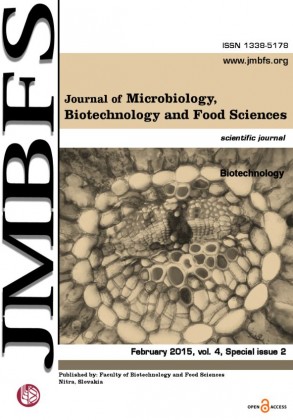ASSESSMENT OF RAPD POLYMORPHISM IN RYE (SECALE CEREALE L.) GENOTYPES
DOI:
https://doi.org/10.15414/jmbfs.2015.4.special2.94-97Keywords:
Rye (Secale cereale L.), polymorphism, RAPD, dendrogramAbstract
The results of genetic analysis of 38 rye taxa (Secale cereale L.) represented by agricultural varieties originating from Central Europe and the Union of Soviet Socialist Republics (SUN) are presented. The genetic diversity of rye cultivars by 5 RAPD markers was evaluated. Five primers gave 42 polymorphic fragments (99.52 %) with an average of 8.4 bands per primer. The most polymorphic primer was RLZ12, where 10 polymorphic amplification products were detected. Overleaf the lowest polymorphic primer was RLZ5 with 7 polymorphic products. Genetic polymorphism was characterized based on diversity index (DI), probability of identity (PI) and polymorphic information content (PIC). The dendrogram of genetic similarity was constructed, based on the Jaccard´s coefficient. In dendrogram three clusters were differentiated. The first cluster contained genotypes from Czechoslovakia, Poland and Czech Republic. The second cluster contained cultivars coming from Union of Soviet Socialist Republics and Hungary. In the next cluster Poland, Czech Republic and Czechoslovakia genotypes were situated. Two genotypes Bosmo and Wibro have not been distinguished. For better distinction of the analysed rye genotypes, it is necessary to use a higher number of RAPD markers. In this experiment, RAPD proved to be a rapid, reliable and practicable method for revealing of polymorphism in the rye cultivars.Downloads
Download data is not yet available.
Downloads
Published
2015-02-02
How to Cite
PetroviÄová, L., Gálová, Z., Balážová, ŽelmÃÂra, VivodÃk, M., Wójcik-JagÅ‚a, M., & Rapacz, M. (2015). ASSESSMENT OF RAPD POLYMORPHISM IN RYE (SECALE CEREALE L.) GENOTYPES. Journal of Microbiology, Biotechnology and Food Sciences, 4(special issue 2 (Biotechnology), 94–97. https://doi.org/10.15414/jmbfs.2015.4.special2.94-97
Issue
Section
Biotechnology
License
Copyright (c) 2015 Lenka PetroviÄová, Zdenka Gálová, ŽelmÃÂra Balážová, Martin VivodÃk, Magdalena Wójcik-JagÅ‚a, Marcin Rapacz

This work is licensed under a Creative Commons Attribution 4.0 International License.
All papers published in the Journal of Microbiology, Biotechnology and Food Sciences are published under a CC-BY licence (CC-BY 4.0). Published materials can be shared (copy and redistribute the material in any medium or format) and adapted (remix, transform, and build upon the material for any purpose, even commercially) with specifying the author(s).





